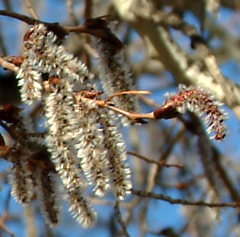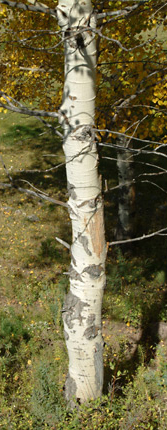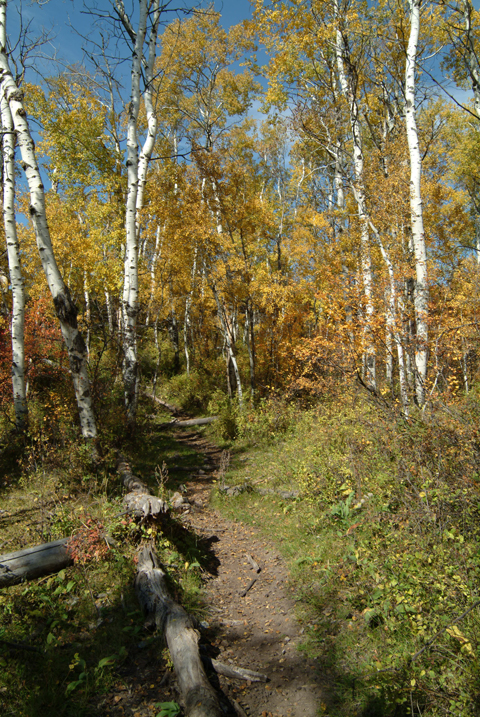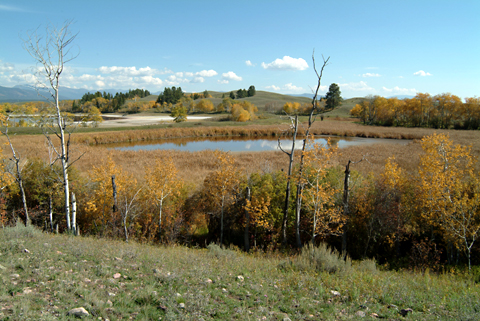Where every breath you draw is exhiliration
-that is where the Aspens grow
First Mention
Several groves of quaking aspen trees enhance the landscape of the area Lewis called “the prarie of the knobs,” from the number of knobs hillocks being irregularly scattered through it. Each grove consists of a large number of clones of a single parent tree. Because the earth sciences as we know them were still in their infancy, Lewis could not have recognized the knobs such as those shown in this photo as moraines or piles of glacial debris, which may have been deposited here as recently as 17,000 years ago. The groves pictured here surround the vestige of a glacial tarn or pond, which now is rimmed by crystallized salt leached from the surrounding soil.
More than a year into the expedition, having traveled hundreds of miles through flora and fauna new to them, Lewis recognized a tree native to New England in the middle of Montana. On 16 July 1805, at “tower rock“—the first “gate of the Rocky Mountains”—near Cascade, Lewis “passed a small stream on which I observed a considerable quantity of aspin [sic],” the party’s first record of quaking aspen, Populus tremuloides. The generic name, Populus (po-pull-us) is Latin for Aspen. This is North America’s most widely distributed tree, occurring from the Atlantic to the Pacific, from interior Alaska, down the Rocky Mountains to Mexico.
The captains noticed aspen again along the Dearborn River on 18 July 1805; near Prickly Pear and Spokane Creeks near Helena, on 20 July 1805; and on 2 July 1806, at Travelers’ Rest near Lolo.
Propagation
Aspen’s broad distribution is not due to tolerance toward a range of climates. Just the opposite. It has a narrow range of environmental tolerance. But it produces trillions of wind-disseminated, short-lived seeds each year with the probability that one will land in a suitable environment, germinate, and develop into a sapling. This life strategy is referred to as “fugitive” species—many seeds scattered so one will land in a rare but suitable refuge. The requirements for successful germination and seedling establishment are so exacting that the probability of success is near zero. The secret is that when a rare seedling establishment occurs, the sapling develops into a grove that may persist for hundreds or even thousands of years by periodic rejuvenation.
Aspen seed requires a flat seedbed that remains moist throughout the summer, free from shade, and free from browsing by wildlife. The last time such seedbeds occurred on a wide scale was on protected silt beds left by retreating glaciers at the end of the ice age. Most of today’s aspen groves are believed to have originated at that time, rejuvenating periodically over the ten millennia since the original seeds germinated. If age is calculated from seed germination, these groves are America’s oldest living trees, even though the above ground portions are generally younger than 100 years.
Aspen rejuvenates by producing two kinds of roots, lateral roots that may radiate out 100 yards or more from the parent tree just below the soil surface, and sinker roots that grow down several feet toward the water table. Lateral roots have about two buds per inch than can develop into sucker shoots. In the young sapling the buds do just that, bypassing critical seedling requirements by nursing by root connection to the parent tree.
Regulation and Renewal
This photo, taken in October 2004, illustrates evidences of genetic diversity among adjacent clones of aspen. Aspen groves self-regulate their stand density and structure. Thus the grove at right foreground already shows its bare branches, while the one beyond it is still clothed in pale green leaves. The leaves of the next grove left of the bare stand are bright orange, and ready to fall. The darker greenish-orange foliage of the grove at extreme right are at an intermediate phase. These adjacent clones are running toward dormancy on slightly different schedules related to diurnal durations.
Nature’s plan requires them to anticipate the need for autumn dormancy before their buds freeze. They retract all the nutrients—especially nitrogen, potassium and phosphorus—from their leaves and put them in the twigs, then harden the bud-scales enough to make them frost-resistant. The precise day and time of the onset of dormancy is related to elevation and latitude, and that timing is crucial. Sudden radical changes in the weather can spell disaster or disappointment. If they grow dormant too late, they risk destroying the ability to retrieve the nutrients in the leaves and not hardening the buds. If they’re not hardened in time, they freeze and die; if they harden too soon, they miss part of the growing season. The schedule observed by a given clone is genetically imprinted, along with its preferred elevation and latitude, in every one of its light, wind-blown seeds.
Leaves of the aspen produce a hormone called auxin that inhibits the development of lateral root buds. As the grove develops, enough hormone is produced and transferred to the roots that sucker buds become dormant. A natural enzyme degrades the hormone as it travels from leaves to root, so sometimes sucker shoots develop from roots that extend far from the parent, such as into a meadow. This strategy, plus shaded branch removal, keeps the canopy open, prevents overcrowding and waste of resources to support sucker growth that cannot survive in shade. Dormant buds rapidly develop into sucker shoots if the lateral root is severed from the parent tree by logging, girdling by fire or animals, or by insect defoliation.
Rejuvenation most commonly occurs after a fire girdles overstory trees. This releases thousands of buds to form new shoots and establish new groves. Each grove is composed of genetically identical trees. Adjacent groves can often be recognized by subtle differences such as bark color, leaf size, date of bud break in the spring or leaf color change in the autumn.
Quaking Aspen
There are few autumn shows that exceed golden-leaved aspen groves, embedded in emerald-colored conifer forests, against an azure sky. The aspen’s one- to three-inch leaves are nearly round except for a point at the apex. Flattened leaf stalks (petioles) are attached to the blades at right angles, allowing the leaves to flutter or tremble in the slightest breeze. This creates the attention-attracting flash between the leaf’s shiny green upper surface and silvery lower surface. The fluttering helps to keep the leaf from over-heating in the summer sun. Aspen’s smooth greenish to creamy-white bark (which may become fissured on old trunks), is marked with eye-shaped black scars where shaded branches have been shed.
Shade Intolerance
Scar made by a young buck deer scraping from his antlers their vascular skin called velvet.
Aspen is very shade intolerant. Some trees reduce the rate of carbohydrate consumption when shaded to match that produced by photosynthesis in reduced light. Aspen does not. In order to prevent shaded branches from consuming more carbohydrate than produced, aspen and many other shade-intolerant trees (e.g., ponderosa pine, lodgepole pine, and larch) shed the shaded branch by forming a breakaway layer where the branch meets the trunk.
Aspen Eco-system
The open canopies of aspen groves allow sunlight to penetrate through to the ground, creating rich and diverse understories of shrubs, forbs, and grasses. This richness and diversity, along with aspen’s palatability, make it the most wildlife-friendly tree in the west. Moose, elk, deer, black bear, and snowshoe hare browse its bark, shoots or buds. Thirty-four species of birds are found in aspen groves. Aspen is a keystone species for ruffed grouse where their ranges overlap. Keystone species irreplaceably provide something for another species at a critical moment. Ruffed grouse chicks feed on insects in a grove’s floor, and during the summer adult grouse feed on a variety of seeds, leaves, and buds. But in winter, when snow covers the ground, the grouse is dependent on the floral buds of the aspen’s male (staminate) catkins.
Grouse may subsist on these catkins alone, but rose hips and willow buds, which develop in the aspen grove understory, are good supplements.
Beaver are aspens’ “sustained yield” foresters. A beaver requires the bark from 200 trees per year for food, and by thus harvesting the trees releases buds for sucker growth and stand replacement for a future generation of beaver.
Aspen Along the Trail
It is not likely that Lewis and Clark encountered many aspen groves as extensive as those found throughout Colorado and Utah. Aspen distribution along the Lolo trail is pretty much as they described it (2 July 1806)—near watercourses and in surrounding meadows. The aspen pictured here have been growing near Lahrity Lake in the Prairie of the Knobs (see Seaman’s Creek) since the end of the last Ice Age. Lewis might have seen them as he passed by in early July 1806, but he didn’t mention them in his journals.
Small groves occur in the moist areas of conifer forests, along with occasional colonies that occupy gaps in the evergreen forest canopy. Forest fires burn through the conifer forests of this region every 100 to 300 years. When this happens aspen quickly establishes an expanded stand from sucker shoots, doing so because sucker shoots grow much faster than the conifers start from seed. In time conifers will overtop the shade intolerant aspen, converting the forest back to conifers, but leaving a few aspen survivors in sunlit canopy gaps or other favored places, awaiting the next post-fire episode to re-establish by sucker shoots another moment in the sun.
Aspen groves elevate themselves above water tables at the “capillary fringe,” where they can draw water up from water table, but are not saturated to the extent that their roots drown. Plants such as cat-tails have systems to transport oxygen to their roots, so they can live in anaeroboic mud and prosper, whereas most plants do not. Note the dead snags in the foreground; the lifespan of an aspen is from 80 to 100 years.
Experience the Lewis and Clark Trail
The Lewis and Clark Trail Experience—our sister site at lewisandclark.travel—connects the world to people and places on the Lewis and Clark Trail.
Discover More
- The Lewis and Clark Expedition: Day by Day by Gary E. Moulton (University of Nebraska Press, 2018). The story in prose, 14 May 1804–23 September 1806.
- The Lewis and Clark Journals: An American Epic of Discovery (abridged) by Gary E. Moulton (University of Nebraska Press, 2003). Selected journal excerpts, 14 May 1804–23 September 1806.
- The Lewis and Clark Journals. by Gary E. Moulton (University of Nebraska Press, 1983–2001). The complete story in 13 volumes.







